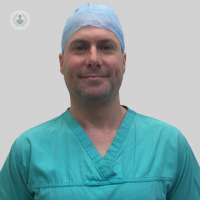Understanding epiretinal membrane: Causes, diagnosis, and surgery
Written in association with:Discover the essentials of epiretinal membrane, also known as macular pucker or vitreomacular traction syndrome. In his latest online article, Mr Craig Goldsmith delves into the causes, highlighting its link to aging and other factors. Learn about the diagnosis process, where eye doctors use drops and scans to assess symptoms impacting vision.

Understanding epiretinal membrane:
Epiretinal Membrane, is a condition characterised by the formation of a thin layer of scar tissue on the surface of the retina, specifically on the macula. The macula is crucial for sharp central vision, necessary for activities like reading and driving. When an epiretinal membrane develops, it may contract and distort the macula, leading to compromised and blurry vision.
Causes of epiretinal membrane
In most instances, epiretinal membrane is associated with natural aging changes within the eye. However, other factors such as diabetes, blood vessel blockages, inflammation, or post-retinal surgery conditions can contribute to its development. Importantly, epiretinal membranes are not linked to macular degeneration and typically do not affect both eyes. This condition is relatively common, affecting up to 8% of individuals in later years.
Diagnosis and assessment
Epiretinal membrane can be detected by an eye doctor during a comprehensive eye examination, often involving the use of eye drops to temporarily dilate pupils. Occasionally, a specialised scan of the back of the eye may be necessary for confirmation. Symptoms and their impact on vision are crucial considerations when deciding whether surgical intervention is necessary.
Expectations with a diagnosis
Discovery of an epiretinal membrane is often incidental during routine eye exams, and vision may remain unaffected in many cases. While some membranes remain stable without impacting vision, others may worsen over time, causing blurred or distorted vision. Treatment becomes necessary only when vision is compromised.
Surgical removal of epiretinal membrane
When an epiretinal membrane affects vision, surgical removal through a procedure known as vitrectomy becomes the primary treatment. This operation involves removing the jelly-like substance (vitreous) from the eye, with no permanent harm aside from expediting cataract development. Vision may be initially blurred after surgery, taking months to improve. The success of the operation in reducing distortion varies, and improvement in sharpness is less predictable if vision was not distorted before surgery.
Risks associated with surgery
Epiretinal membrane removal surgery carries potential risks, such as an accelerated onset of cataracts. Serious complications, though rare, include worsened vision, recurrent membrane formation, retinal detachment, and, in extreme cases, total blindness. Some patients may develop glaucoma, requiring ongoing management to preserve vision.
Post-surgery guidelines
After surgery, patients receive eye drops for a few weeks to aid in recovery. Hospital stay is typically one night, and follow-up appointments occur a couple of weeks after the procedure. Depending on the surgery type and the nature of one's work, a minimum of two weeks off work is generally recommended, with specific details discussed with the surgeon. Daily activities can be resumed, but precautions to avoid injury and unhygienic environments are advised.
Mr Craig Goldsmith is an esteemed ophthalmologist. You can schedule an appointment with Mr Goldsmith on his Top Doctors profile.


